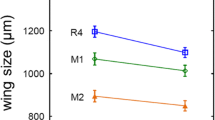Abstract
The effects of various temperatures on adultDrosophila willistoni Sturtevant infected withNosema kingi Kramer were studied. The minimal and maximal temperatures for the normal development of both the host and parasite were 17±2°C and 27±2°C respectively. 22±2°C appeared to be the optimal temperature rature for rearing both the host and parasite since the life span of the flies and the parasite burden were greatest at this temperature. Generally, as the temperature increased, the life span of the adultD. willistoni decreased.
Résumé
On a étudié les effets de diverses températures sur l'adulte deDrosophila willistoni Sturtevant infecté parNosema kingi Kramer. Les températures maximales et minimales pour le développement normal à la fois de l'hôte et du parasite sont 27°±2°C et 17°±2°C respectivement. Une température de 22°±2°C correspond à l'optimum pour l'élevage de l'hôte et du parasite, car la longévité des mouches et la charge en parasites sont les plus élevées à cette température. En général, lorsque la température augmente, la longévité des adultes deD. willistoni diminue.
Similar content being viewed by others
References
Allen, H. &Brunson, M.—1947. Control ofNosema disease of a potato tuberworm, a host used in the mass production ofMacrocentrus ancylivorus.—Science, 105, 394.
Astaurov, B., Baburashvili, E., Bednyakova, T., Vereiskaya, V., Lobzhanidize, V. &Ovanesyan, T.—1969. Thermal intravital disinfection of eggs with simultaneous elimination of the embryonic diapause as a new method of control of silkworm pebrine disease.—Izv. Akad. Nauk SSR Ser. Biol, 6, 811–818 (in Russian).
Bednyakova, T. &Vereiskaya V.—1958. The disinfection of pebrinous silkworm eggs by means of sublethal temperatures.—Dokl. Akad. Nauk. SSSR Biol Sci. Sect., 119, 249–252 (in Russian).
Bednyakova, T. &Vereiskaya V.—1958a. The disinfectant action of high temperatures on the eggs of the mulberry silkworm (Bombyx mori L.).—Akad. Nauk SSSR Biol Sci. Sect., 122, 760–763 (in Russian)
Cantwell, G.—1970. Standard methods for countingNosema spores.—Am. Bee J., 110, 222–223.
Chapman, R.—1969. The Insects: Structure and Function.—Am. Elsevier Publ. Co., New York.
Hollingsworth, M.—1969. Temperature and length of life inDrosophila.—Exp. Geront., 4, 49–55.
Kramer, J.—1964.Nosema kingi, sp. n., a microsporidian fromDrosophila willistoni Sturtevant and its infectivity for other muscoids.—J. Invertebr. Pathol., 6, 491–499.
Maddox, J.—1966. Studies on a microsporidiosis of the armyworm,Pseudaletia unipuncta (Haworth).—Ph. D. thesis. Univ. Illinois, Urbana, Illinois.
Ovanesyan, T. &Lobzhanidize, V.—1958. First results of experiments on the thermal disinfection of pebrinous silkworm eggs by a brief immersion in hot water.—Tr. Inst. Morfol. Zhivotnykh Akad. SSSR, 21, 184–215 (in Russian).
Plough, H. &Strauss, M.—1923. Experiments on the toleration of temperatures byDrosophila.—J. Gen. Physiol., 9, 513.
Smyk, D.—1959. Méthodes physiques de lutte contreNosema bombycis dans les graines du ver à soie du murier.—Rev. Ver à Soie, 11, 155–161.
Steinhaus, E.—1963. Insect Pathology, An Advance Treatise (E. Steinhaus, ed.), Vol. 2.—Academic Press, New York.
Weiser, J.—1961.Monogr. Angew. Entomol. (Beihifte zurZ. Angew. Entomol.), 17, 149 pp (Informal translation byL. Szalay andJ. Kramer).
Wilson, G.—1972. Studies onNosema fumiferanae, a microsporidian parasite ofChoristoneura fumiferana (Clem.)[Lepidoptera: Tortricidae].—Ph. D. Ihesis, Cornell University, Ithaca, New York.
Young, W. &Plough, H.—1926. On the sterilization ofDrosophila by high temperatures.—Biol. Bull., 51, 189.
Author information
Authors and Affiliations
Rights and permissions
About this article
Cite this article
Armstrong, E. The effects of temperature on the longevity of adultDrosophila willistoni infected withNosema kingi . Entomophaga 21, 201–205 (1976). https://doi.org/10.1007/BF02371906
Issue Date:
DOI: https://doi.org/10.1007/BF02371906




